Abstract
OBJECTIVE--The study was designed to examine the effects of age on sleep and the circadian rhythms during consecutive night shifts. METHODS--Two groups of letter sorters (19-29 (n = 7) and 53-59 (n = 7) years of age were studied in a sleep laboratory under closely controlled conditions. After two baseline days, circadian adjustment to three night shifts was monitored by continuous measurement of rectal temperature, salivary melatonin, and sleep-wakefulness during the night shifts. RESULTS--Age was significantly related to the adjustment to night work of rectal temperature minimum and of self rated sleepiness. Young subjects delayed their temperature phase and decreased sleepiness more than the older subjects. Age was also significantly related to an increase of alertness and to the feeling of being refreshed after the day sleep. Although there were basic differences in sleep duration and structure between the age groups, the latter did not change across the night shifts. CONCLUSION--Aging decreases the ability to recover after several, but not after the first night shift.
Full text
PDF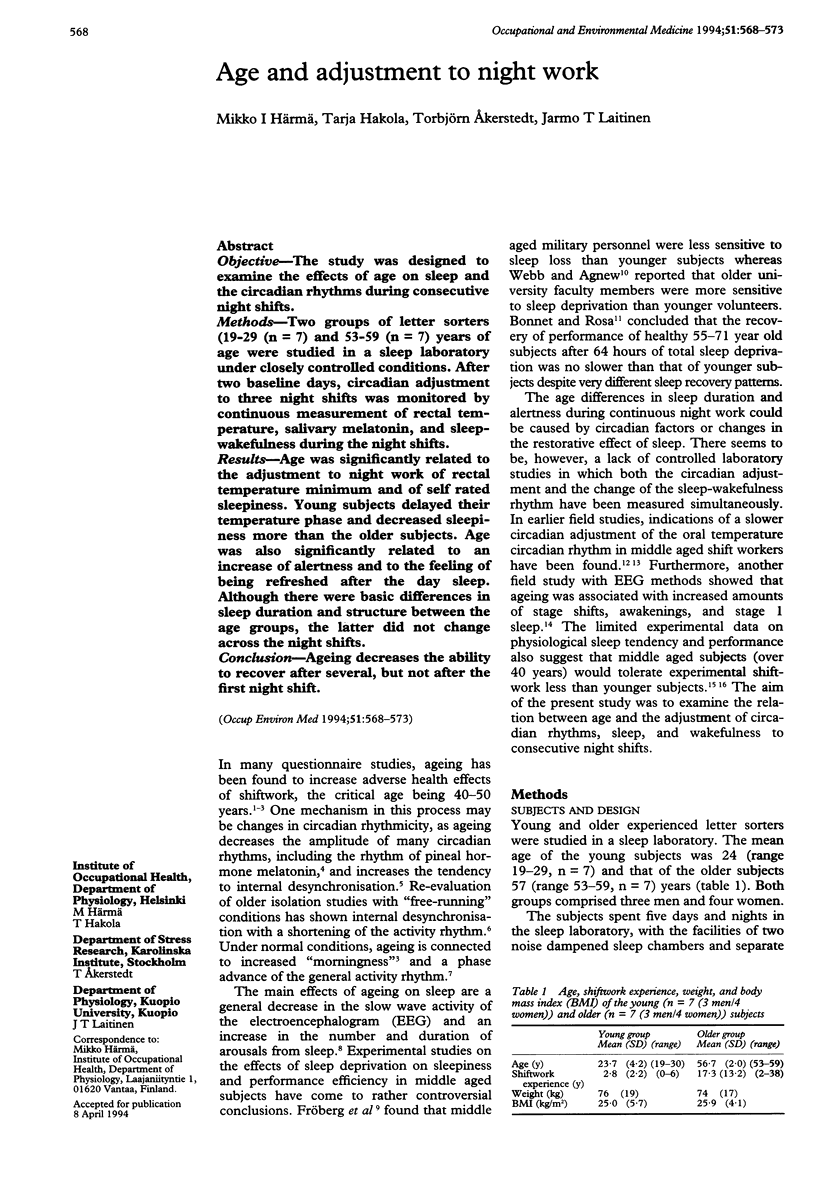

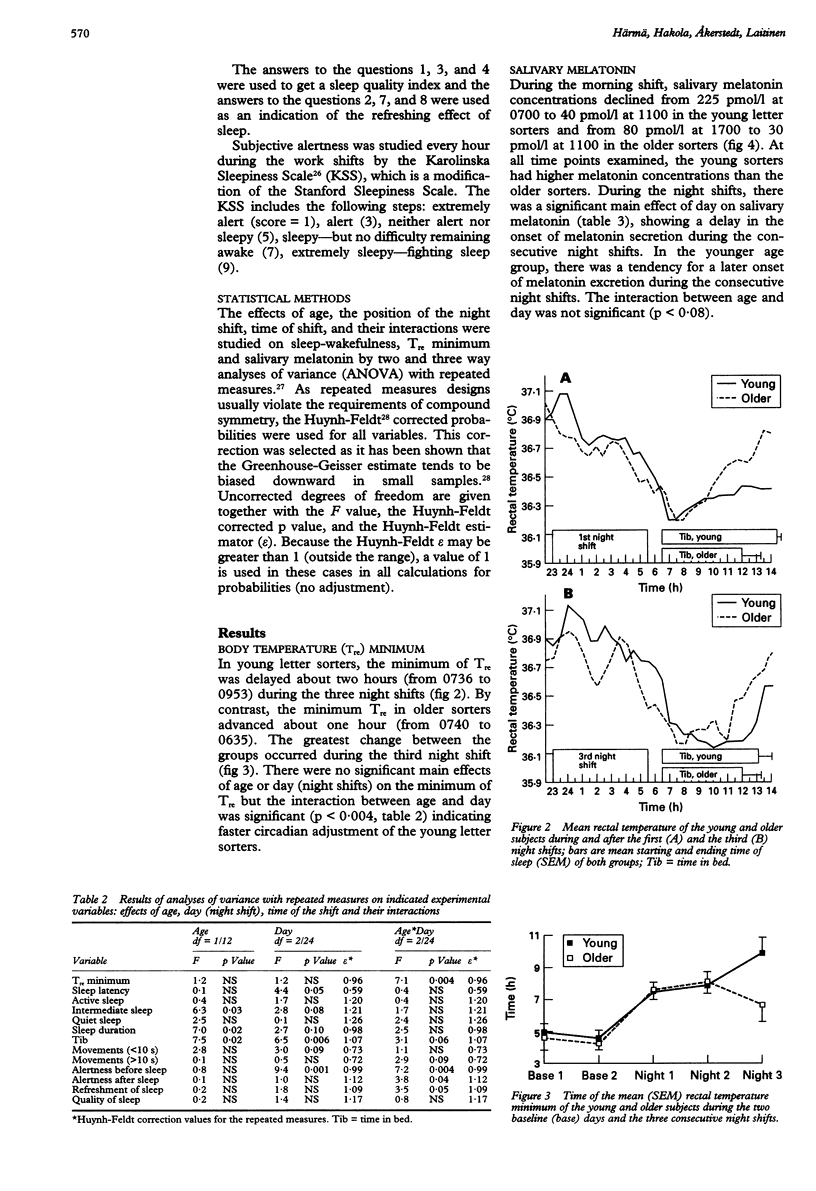
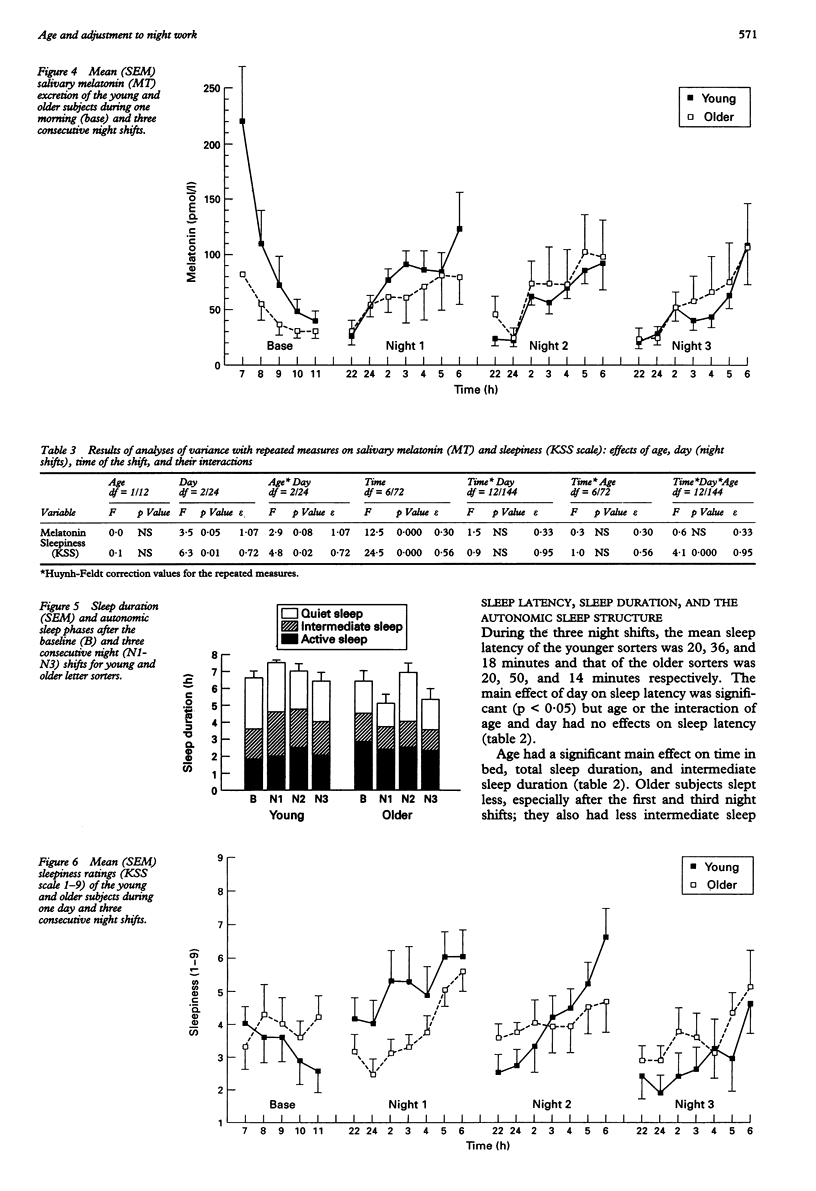
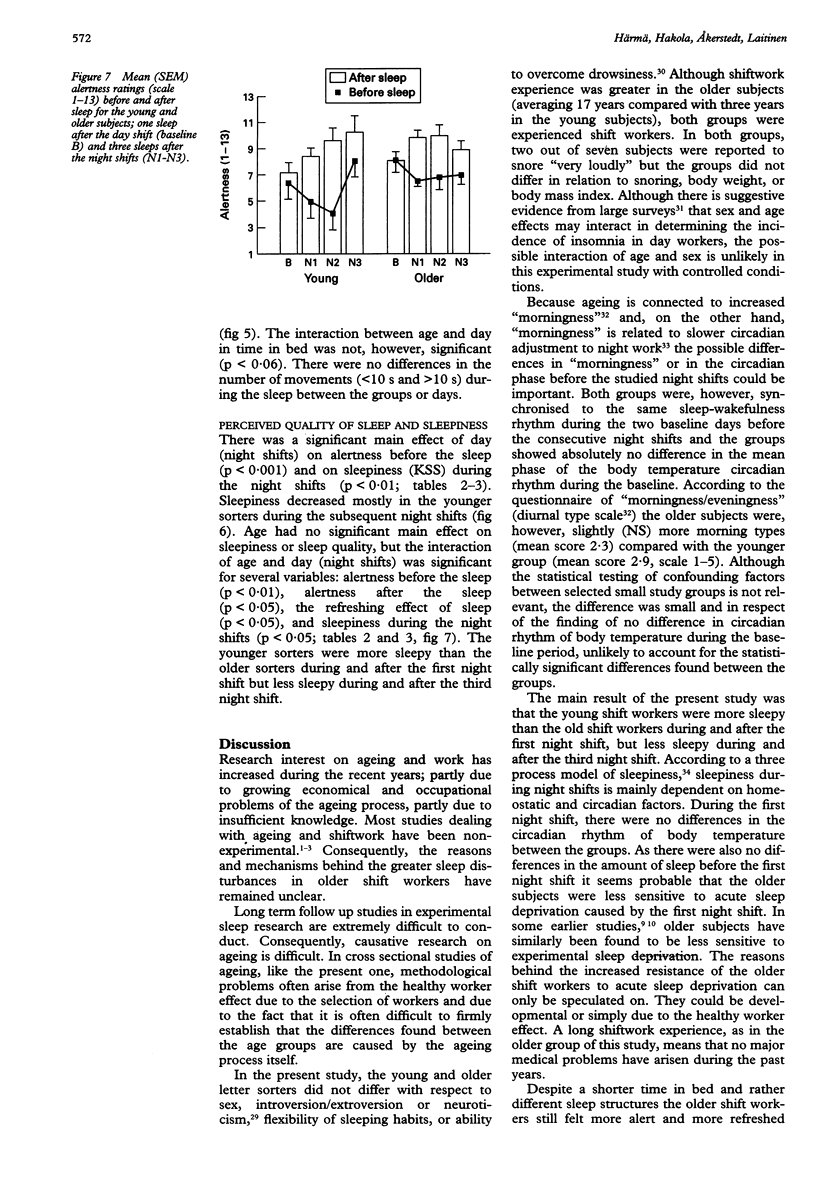
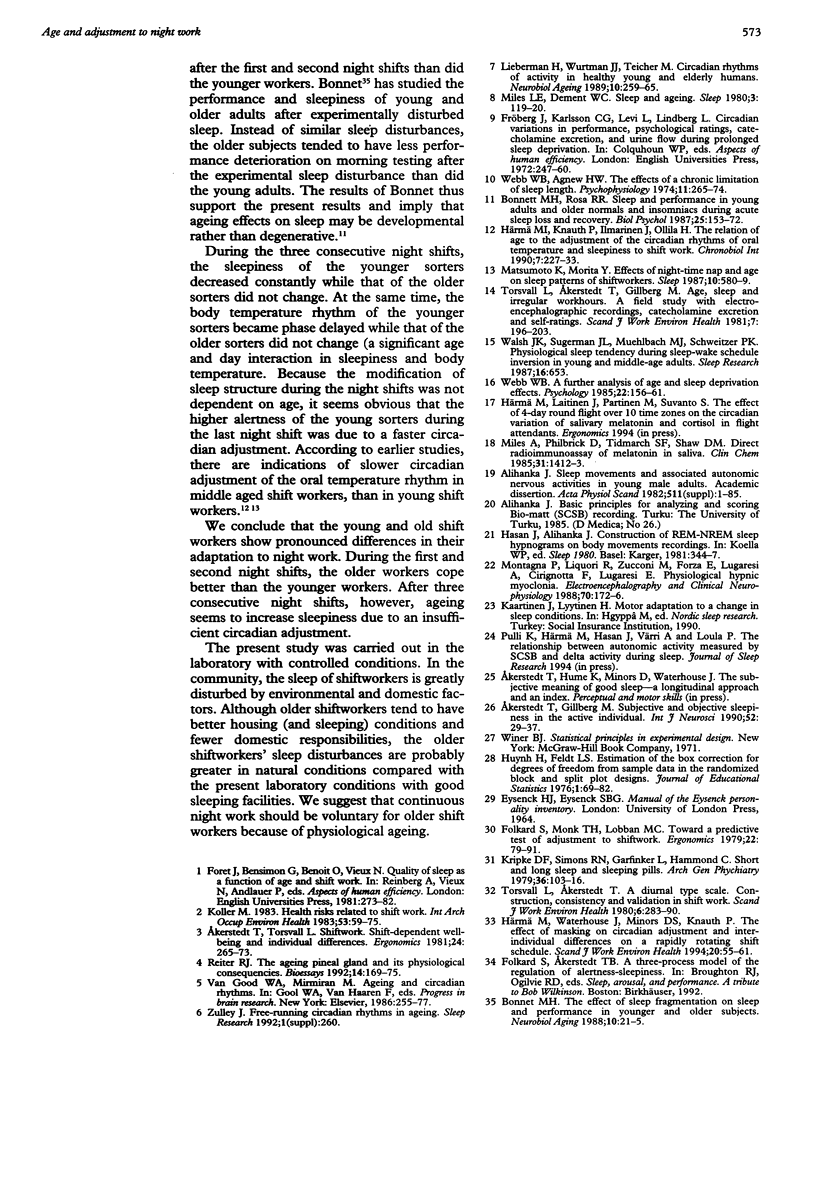
Selected References
These references are in PubMed. This may not be the complete list of references from this article.
- Akerstedt T., Gillberg M. Subjective and objective sleepiness in the active individual. Int J Neurosci. 1990 May;52(1-2):29–37. doi: 10.3109/00207459008994241. [DOI] [PubMed] [Google Scholar]
- Alihanka J. Sleep movements and associated autonomic nervous activities in young male adults. Acta Physiol Scand Suppl. 1982;511:1–85. [PubMed] [Google Scholar]
- Bonnet M. H., Rosa R. R. Sleep and performance in young adults and older normals and insomniacs during acute sleep loss and recovery. Biol Psychol. 1987 Oct;25(2):153–172. doi: 10.1016/0301-0511(87)90035-4. [DOI] [PubMed] [Google Scholar]
- Folkard S., Monk T. H., Lobban M. C. Towards a predictive test of adjustment to shift work. Ergonomics. 1979 Jan;22(1):79–91. doi: 10.1080/00140137908924591. [DOI] [PubMed] [Google Scholar]
- Härmä M., Knauth P., Ilmarinen J., Ollila H. The relation of age to the adjustment of the circadian rhythms of oral temperature and sleepiness to shift work. Chronobiol Int. 1990;7(3):227–233. doi: 10.3109/07420529009056979. [DOI] [PubMed] [Google Scholar]
- Härmä M., Waterhouse J., Minors D., Knauth P. Effect of masking on circadian adjustment and interindividual differences on a rapidly rotating shift schedule. Scand J Work Environ Health. 1994 Feb;20(1):55–61. doi: 10.5271/sjweh.1428. [DOI] [PubMed] [Google Scholar]
- Koller M. Health risks related to shift work. An example of time-contingent effects of long-term stress. Int Arch Occup Environ Health. 1983;53(1):59–75. doi: 10.1007/BF00406178. [DOI] [PubMed] [Google Scholar]
- Kripke D. F., Simons R. N., Garfinkel L., Hammond E. C. Short and long sleep and sleeping pills. Is increased mortality associated? Arch Gen Psychiatry. 1979 Jan;36(1):103–116. doi: 10.1001/archpsyc.1979.01780010109014. [DOI] [PubMed] [Google Scholar]
- Lieberman H. R., Wurtman J. J., Teicher M. H. Circadian rhythms of activity in healthy young and elderly humans. Neurobiol Aging. 1989 May-Jun;10(3):259–265. doi: 10.1016/0197-4580(89)90060-2. [DOI] [PubMed] [Google Scholar]
- Matsumoto K., Morita Y. Effects of nighttime nap and age on sleep patterns of shift workers. Sleep. 1987 Dec;10(6):580–589. [PubMed] [Google Scholar]
- Miles A., Philbrick D., Tidmarsh S. F., Shaw D. M. Direct radioimmunoassay of melatonin in saliva. Clin Chem. 1985 Aug;31(8):1412–1413. [PubMed] [Google Scholar]
- Montagna P., Liguori R., Zucconi M., Sforza E., Lugaresi A., Cirignotta F., Lugaresi E. Physiological hypnic myoclonus. Electroencephalogr Clin Neurophysiol. 1988 Aug;70(2):172–176. doi: 10.1016/0013-4694(88)90116-2. [DOI] [PubMed] [Google Scholar]
- Reiter R. J. The ageing pineal gland and its physiological consequences. Bioessays. 1992 Mar;14(3):169–175. doi: 10.1002/bies.950140307. [DOI] [PubMed] [Google Scholar]
- Torsvall L., Akerstedt T. A diurnal type scale. Construction, consistency and validation in shift work. Scand J Work Environ Health. 1980 Dec;6(4):283–290. doi: 10.5271/sjweh.2608. [DOI] [PubMed] [Google Scholar]
- Van Gool W. A., Mirmiran M. Aging and circadian rhythms. Prog Brain Res. 1986;70:255–277. doi: 10.1016/s0079-6123(08)64309-5. [DOI] [PubMed] [Google Scholar]
- Webb W. B. A further analysis of age and sleep deprivation effects. Psychophysiology. 1985 Mar;22(2):156–161. doi: 10.1111/j.1469-8986.1985.tb01579.x. [DOI] [PubMed] [Google Scholar]
- Webb W. B., Agnew H. W., Jr The effects of a chronic limitation of sleep length. Psychophysiology. 1974 May;11(3):265–274. doi: 10.1111/j.1469-8986.1974.tb00543.x. [DOI] [PubMed] [Google Scholar]


